The Enchanting Spirit Houses of Thailand: A Guide to Protection and Appeasement

The Enchanting Spirit Houses of Thailand: A Guide to Protection and Appeasement
Okay, let's talk about something truly enchanting and quintessentially Thai: Spirit Houses. If you've ever traveled to Thailand, you've undoubtedly seen them. These miniature temples, often brightly colored and intricately decorated, are perched outside homes, businesses, and even seemingly random spots along the roadside. But these aren't just cute decorations; they're deeply ingrained in Thai culture and represent a profound connection to the spirit world. I remember the first time I saw one, I was completely captivated. It looked like a tiny, perfect home, and I was immediately curious about its purpose. Over the years, I've learned so much about them, and I'm excited to share my understanding with you.
What Exactly Are Spirit Houses?

Simply put, spirit houses, known as san phra phum (ศาลพระภูมิ) in Thai for houses dedicated to the guardian spirit of the land and san chao tii (ศาลเจ้าที่) for houses dedicated to the ancestral spirits, are miniature shrines built to appease the spirits that reside on a property. The belief is that when a building is constructed, it displaces the spirits that previously occupied that land. Rather than having these spirits become angry or disruptive, the spirit house provides them with a new, more comfortable home. Think of it as offering them a better place to live so they don't cause any trouble!
There are generally two types of spirit houses you'll encounter:
- Phra Phum (Guardian Spirit Houses): These are dedicated to the Chao Thi, the Lord of the Land, who is believed to be the protector of the property. They're often more elaborate and elevated, symbolizing the high status of the spirit they house.
- San Chao Tii (Ancestor Spirit Houses): These are for the spirits of deceased ancestors or other local spirits. They're typically smaller and placed closer to the ground.
Understanding the difference between these two types is key to appreciating the nuances of Thai spiritual beliefs. They reflect a deep respect for the unseen forces that are believed to influence our lives.
The Beliefs Behind the Miniature Temples

The practice of building spirit houses stems from a blend of animism, Buddhism, and Brahmanism – a fascinating mix that shapes much of Thai culture. The animistic aspect recognizes that spirits exist everywhere – in trees, rocks, and, of course, the land itself. The Buddhist influence encourages offering and respect for all beings, while Brahmanism contributes deities and rituals to the process.
The underlying belief is that these spirits, if properly cared for and respected, can bring good fortune, protection, and prosperity to the residents or owners of the property. Conversely, neglecting or disrespecting the spirits can lead to misfortune, illness, or financial hardship. It's all about maintaining a harmonious relationship with the spirit world. I've heard stories from Thai friends about attributing both good and bad luck to the proper (or improper) care of their spirit houses. It's definitely a taken seriously!
The Construction and Placement of Spirit Houses

Building a spirit house isn't something you just decide to do on a whim. It's a significant event often involving a Brahmin priest or a monk. Here's a general overview of the process:
- Consultation: First, a Brahmin priest or monk is consulted to determine the most auspicious location and orientation for the spirit house. This often involves astrological calculations and consideration of the surrounding environment.
- Construction: The spirit house itself can range from simple wooden structures to elaborate miniature temples made of concrete or other materials. They're often purchased from specialized shops and then customized with decorative elements.
- Installation: The installation ceremony is a significant event, often involving chanting, offerings, and the placement of spirit figures within the house. These figures typically represent the Chao Thi, his family, and attendants.
- Placement: The spirit house is typically placed outside the main building, often in a prominent location within the garden or on a platform. It's important that it's in a clean and respectful area, away from garbage or other unsightly things.
The orientation is crucial, typically facing in a direction that is considered auspicious based on the lunar calendar and the individual property. This ensures that the spirits are positioned favorably to protect and bless the residents.
Offerings and Upkeep: Caring for Your Spiritual Neighbors

The daily upkeep of a spirit house is an essential part of maintaining a good relationship with the spirits. It's not just about building the house; it's about continually showing respect and appreciation. Here's what's typically involved:
- Daily Offerings: Fresh flowers (often jasmine or lotus), incense sticks, water, and sometimes small food items (like fruit or sweets) are offered daily. These offerings provide sustenance and pleasure to the spirits.
- Special Occasions: On special occasions, such as Buddhist holidays or birthdays, more elaborate offerings are made, including cooked meals, desserts, and even miniature performances (like small dances or plays).
- Cleaning: The spirit house is regularly cleaned to keep it free from dust and debris. This shows respect for the spirits and ensures they have a pleasant dwelling.
- Repairs: If the spirit house becomes damaged or dilapidated, it's important to repair it promptly. This demonstrates a commitment to providing the spirits with a comfortable home.
I've seen families in Thailand take these offerings very seriously. It's not just a chore; it's a heartfelt expression of their beliefs and a way to connect with the spiritual realm. Remember, even a simple gesture of respect, like lighting an incense stick, can go a long way.
The Symbolic Meaning of the Offerings

The offerings placed in spirit houses are rich in symbolic meaning, each item carefully chosen to convey respect and provide nourishment to the resident spirits. Here's a closer look at some of the common offerings and what they represent:
- Flowers: Flowers, especially jasmine and lotus, symbolize purity, beauty, and respect. They are offered to please the spirits and create a serene atmosphere.
- Incense: The smoke from burning incense is believed to carry prayers and offerings to the spirit world. The fragrant smoke is thought to purify the space and attract positive energy.
- Water: Water is a symbol of life and purity. Offering water provides the spirits with refreshment and sustenance.
- Food: Offerings of food, such as rice, fruit, and sweets, are intended to nourish the spirits and show generosity. These offerings reflect the belief that the spirits have the same needs and desires as humans.
- Miniature Statues: Small statues of dancers, musicians, or animals are often placed in the spirit house to provide entertainment and companionship to the spirits.
Understanding the symbolic significance of these offerings can deepen your appreciation of the care and thought that goes into maintaining a spirit house. It's a way of connecting with the spirit world and showing respect for the unseen forces that influence our lives.
Spirit Houses in Modern Thailand

Even in modern Thailand, with its bustling cities and technological advancements, the tradition of spirit houses remains strong. While some might view it as an outdated superstition, it's actually a testament to the enduring power of cultural beliefs. You'll find spirit houses outside gleaming skyscrapers and modern shopping malls, a reminder that the spiritual realm is always present, even in the most urban environments.
The design of spirit houses has also evolved over time, with some incorporating modern architectural elements while still adhering to traditional principles. This shows how Thai culture seamlessly blends the old with the new, preserving its unique identity while embracing progress. I think it's a beautiful example of how tradition can remain relevant and meaningful in a constantly changing world.
Common Mistakes to Avoid

When interacting with spirit houses, especially as a tourist, it's important to be respectful and avoid making any cultural faux pas. Here are a few common mistakes to avoid:
- Touching without Permission: Avoid touching the spirit house or any of the offerings without permission. It's considered disrespectful to tamper with these sacred items.
- Pointing Your Feet: In Thai culture, pointing your feet at someone or something is considered rude. Avoid pointing your feet at a spirit house.
- Wearing Inappropriate Clothing: When visiting a spirit house, dress respectfully. Avoid wearing revealing clothing or anything that might be considered offensive.
- Making Loud Noises: Be mindful of your volume and avoid making loud noises or disruptive behavior near a spirit house.
- Disposing of Trash Nearby: Never dispose of trash or litter near a spirit house. It's important to keep the area clean and respectful.
By being aware of these simple guidelines, you can show respect for Thai culture and avoid inadvertently offending anyone.
My Personal Experiences and Encounters

Over the years, I've had several memorable experiences involving spirit houses in Thailand. One that stands out was when I was visiting a small village in northern Thailand. I noticed a spirit house that was particularly elaborate and well-maintained. I struck up a conversation with the owner of the house, an elderly woman who told me stories about the spirits that resided within and the blessings they had brought to her family.
She explained how she made daily offerings of fresh flowers and food, and how she believed that the spirits were always watching over her and her loved ones. Her devotion was truly inspiring, and it gave me a deeper understanding of the profound connection that Thai people have with the spirit world. It was a humbling experience and reinforced my respect for their traditions.
Where to Learn More About Spirit Houses

If you're interested in learning more about spirit houses, here are a few resources that you might find helpful:
- Local Temples: Many temples in Thailand offer guided tours and explanations of the significance of spirit houses.
- Cultural Centers: Cultural centers and museums often have exhibits and information about Thai traditions, including spirit houses.
- Books and Articles: There are numerous books and articles available online and in libraries that delve into the history and beliefs surrounding spirit houses.
- Conversations with Locals: Don't be afraid to strike up conversations with local Thai people and ask them about their experiences and beliefs regarding spirit houses.
By exploring these resources, you can gain a more comprehensive understanding of the rich cultural heritage that surrounds spirit houses in Thailand.
Spirit Houses: A Window into the Thai Soul

Ultimately, spirit houses are more than just miniature temples; they're a window into the soul of Thailand. They reflect the deep respect for the spiritual realm, the importance of maintaining harmony with nature, and the enduring power of cultural traditions. The next time you see a spirit house in Thailand, take a moment to appreciate its beauty, its significance, and the rich history it represents. It's a small reminder of the unseen forces that shape our world and the importance of treating them with respect and reverence. These little homes are a powerful symbol of Thai beliefs and a testament to the enduring strength of their culture. I hope this has given you a bit more insight into the fascinating world of Thai spirit houses!
Post a Comment